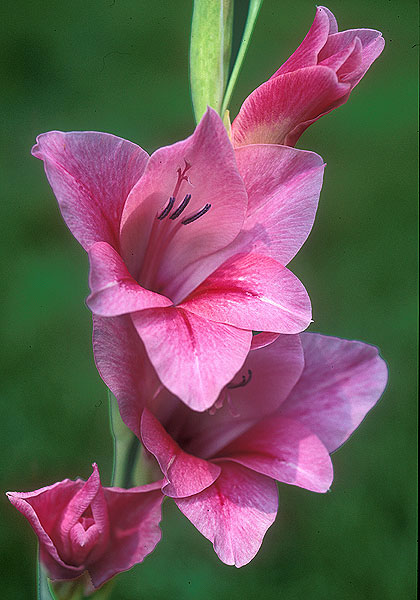|
|


|
|
What a find! From old country gardens in the Great Smoky Mountains comes this graceful, small-flowered, clump-forming, rosy-pink, pass-along glad. We’ve named it in honor of Beuna Winchester (say BYOON-uh), ambassador of old-time mountain culture, who’s been nurturing it ever since it grew in her mother’s garden 70 or more years ago. We hope you’ll join us in preserving it! Last offered in spring 2004. Although we lost our entire stock, we’re still hopeful that we’ll be able to offer it again someday. |
|
TYPE primulinus SUB TYPE small, primulinus ZONES 8a-9b(10bWC) HEIGHT 36” LIGHT full sun |
PLANTING & CAREPlant after danger of frost is past — when you’d plant tomatoes. Glads planted in cold soils may rot. Open the bags and store till then in a cool, dim, dry place. 45-55° F is ideal, but close will do. For a succession of bloom, follow old-time advice and soak some corms before planting to speed them into growth and bloom. Or plant a few every week or two till the end of early summer (for example, late June in zone 5). Don’t wait too late, though, because some heirlooms need a longer season than many modern glads to bloom. Pick a sunny site. Glads are easy and adaptable, but loose, fertile, well-drained soil with a pH of 6.5 to 6.8 is ideal for them. Avoid heavy soils that stay wet. Plant 4-6 inches apart and 2-6 inches deep, the side with the round indentation in the middle facing down. Shallow planting gives the corms warmer soil to spur growth but it may lead to a need for staking. To help avoid this, mound soil 2-3 inches around the base of the stalk later, before bloom. Water once, but then unless it’s very dry, wait till growth emerges before beginning to water regularly and deeply enough to reach the corm. Expert glad-growers often recommend mulching to maintain more even moisture. Fertilize when growth begins and again after cutting flowers, ideally with a liquid fertilizer. Don’t overdo it, though. Too little is better than too much. THRIPS are one of the few pests that bother glads. They’re almost invisible but they can be devastating. To learn more, click here. WINTER CARE — In zones 8 and warmer (lows to 10° F), glads can stay in the ground year round. They often survive winters in zones 7, 6, and even 5, too, according to many of our customers. Learn more at our Surprisingly Hardy Glads page. Otherwise, glads are one of the easiest bulbs to store (if you want to). Dig 5-6 weeks after flowering or at killing frost. Cut stalk off as close to the corm as possible. Experts often recommend a 5-minute fungicide dip, or you can dust them with an insecticide-fungicide, or do nothing. Air dry for a few weeks. Store loose or in mesh bags in a cool, dry place with good air circulation, ideally at 35-45° F. In spring, break off the old, shriveled corm at the base of each new one. CORMLETS bigger than a pea may bloom the next year, and smaller ones in two. Plant cormlets 1-2 inches deep and 1-2 inches apart, depending on size. Immediately before planting, nick, gently crack, or dissolve hard outer coats by soaking in bleach for a few hours. Learn more. Learn more about growing and enjoying glads at our Gladiolus Newsletter Archives and Bulbs as Cut-Flowers page. |

|
SPRING
|
· |
SUMMER
|
· |
FALL
|
· |
LEARN MORE
|
· |
ORDERING
|

|










